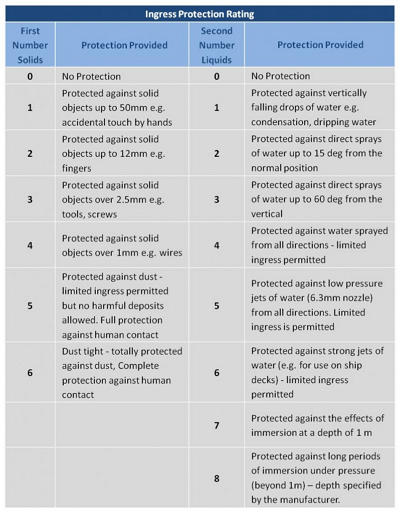 Understanding IP Ratings (Ingress Protection) – IP53 vs IP55 vs IP67
Understanding IP Ratings (Ingress Protection) – IP53 vs IP55 vs IP67

Courtesy of Wireless Telecom Group, Inc.
Have you ever seen “IP55” or something similar written on the specs of a mobile or handheld radio? Do you know what it means?
“IP” stands for “Ingress Protection” and is a standard promulgated by the International Electrotechnical Commission. It allows you to quantify somewhat nebulous marketing terms like “waterproof,” “water resistant,” “dust resistant,” etc.
The chart above shows how to easily read an IP rating code. The first number denotes the protection against solid objects (think a finger, paperclip through a ventilation hole, or even dust). The second number denotes the liquid protection which can include direct sprays under pressure or even total immersion.
One of the more common ratings we see in portable radios is “IP55” which means that it’s protected against “dust…” and “low pressure jets of water….” Some models like the Wouxun KG-UV3D, KG-UV6D, and KG-UV8D all claim this rating. Other models such as the new AnyTone Tech TERMN-8R claim an “IP53” rating which provides equal dust protection but slightly less water protection. For other radios it’s hard to find an IP rating at all. For example, the Baofeng UV-5R is listed as “IP54” on some Chinese websites but the reliability of that is unknown.
Some uses such as firefighting or military require higher standards because of more extreme environments. For example, Kenwood and Motorola both offer fully submersible models with a rating of “IP67” (dust-tight and immersion to 1m). Ed at Import Communications just announced an upcoming release of the Anytone AT-3140UV which also claims a rating of “IP67.”
Keep in mind that some manufacturers “self-certify” their products rather than submitting them to an outside testing firm. You’ll see specs like “meets IP55 rating” which doesn’t tell you anything about who really did the testing — or whether it actually meets the rating. Caveat emptor!














Baofeng indeed makes radios which confirm to a certain IP rating, but in in general only one: a test sample. When the radio goes into production the necessary sealing is nowhere to be found.
That’s disappointing. I’m not sure I’d even want to take my UV-3R out into the rain. I have little experience with the water resistance of Baofeng’s other models.
I have a kenwood th-f6a it says on the brochure that it’ll take light rain but dosent give a rating so what would it be I wonder? plus I like the yaesu ft-270r its super tough as I have submersed it under water and it still works solid! 🙂
I work in the marine industry and we deal with these ratings all of the time in our products. The chart does not indicate, as an example, that IP67 is usually rated for a time, also. Another thing is that the temperature of the device under test or the temperature of the water spray is not noted. There is a big difference taking a very warm radio and immersing it into ice cold water versus a warm radio into warm water. The higher the delta temperature between the radio and the water, the more that air tends to move back and forth across the seals either as vacuum or pressure induced. Hot radios into cold water tend to suck in the water. Just a note of caution concerning the ratings is that one should be skeptical.
Great followup, Mark. Cool info about the temperature between the water and the radio — never even considered that it could make a difference!
Sainsonic RST599 is water proof, BF-9700 IP67 Waterproof too, guys you are too old to use internet? silly…
I have a smart watch with a IP 56 water rating , does this mean it is water resistance and at what depth , can I swim with it ?